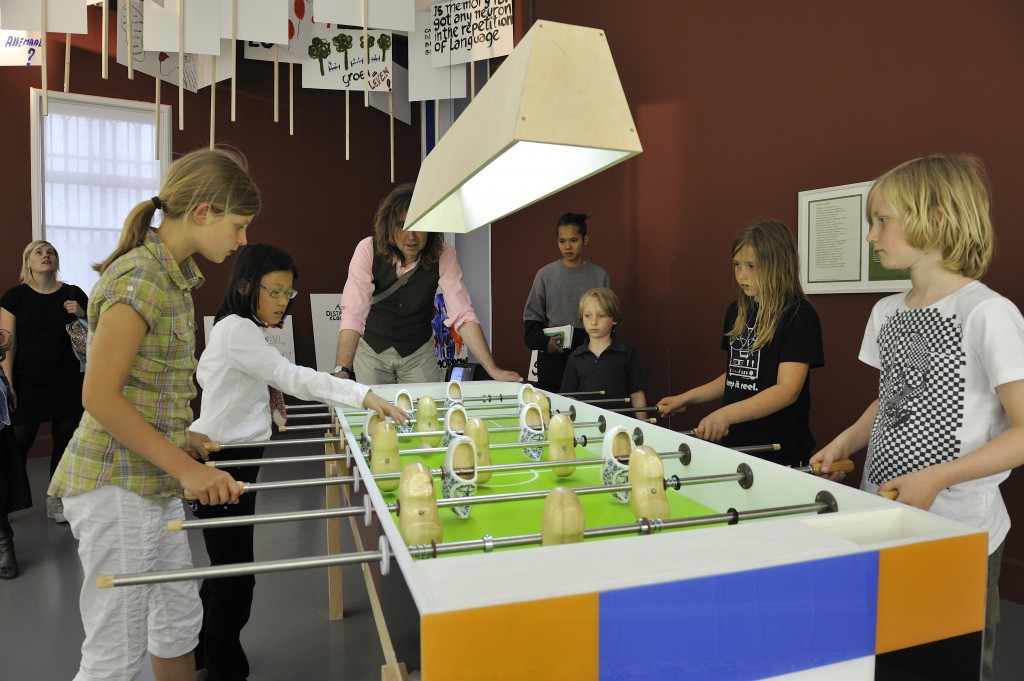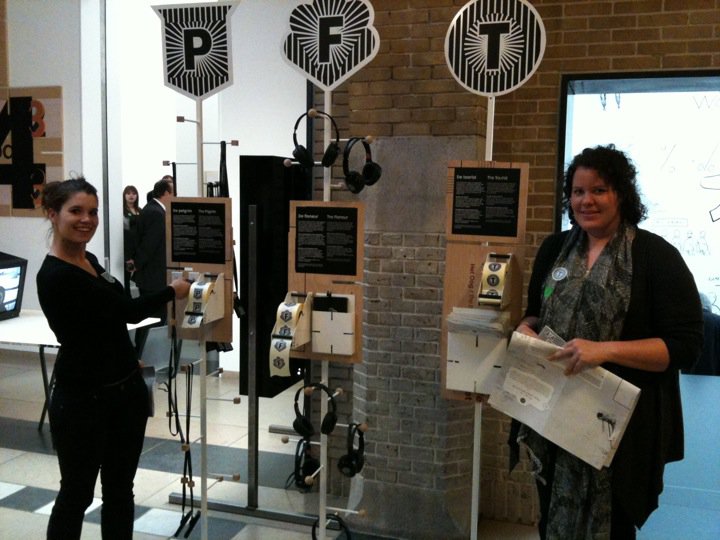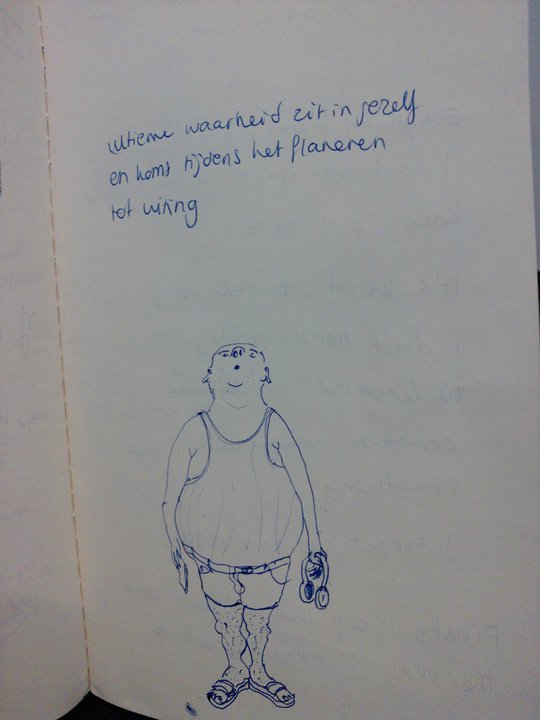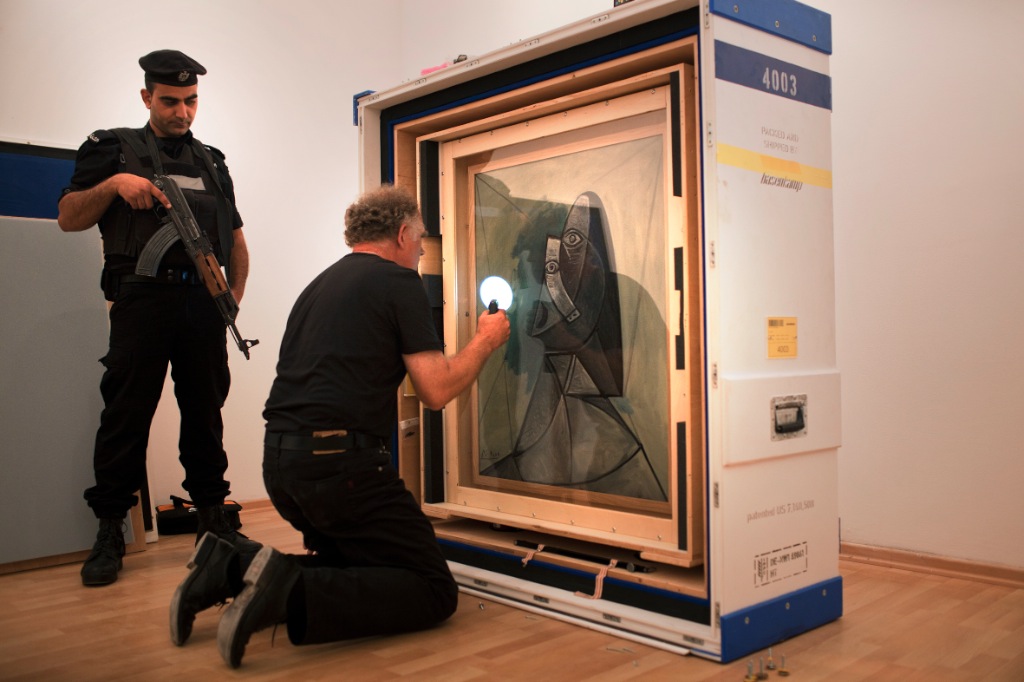 Careful readers have probably noticed the high number of features that the Van Abbemuseum in Eindhoven has gained in the press over the past few months. Even though the museum of modern and contemporary art is often praised both nationally and internationally, it suffers from increasing criticism by the local authorities. On the one hand the museum is recognized as an eminent institute with a progressive vision on museum´s future legitimacy, on the other it is despised as a radical and elitist bastion with its back towards the city of Eindhoven and shirking away of cultural entrepreneurship.
Careful readers have probably noticed the high number of features that the Van Abbemuseum in Eindhoven has gained in the press over the past few months. Even though the museum of modern and contemporary art is often praised both nationally and internationally, it suffers from increasing criticism by the local authorities. On the one hand the museum is recognized as an eminent institute with a progressive vision on museum´s future legitimacy, on the other it is despised as a radical and elitist bastion with its back towards the city of Eindhoven and shirking away of cultural entrepreneurship.
In this essay, I´d like to contribute to the current social debate about numbers of visitors and budget cuts in arts & culture by the Dutch government. I will demonstrate in which ways the Van Abbemuseum is a leading figure in contemporary museum discourse. Based on their recent exhibition policy, I wish to discuss notions such as interpassivity, breaching old epistemes, and the rise of metamodernism. The main argument will be that the acclaimed tendencies of more participation of visitors have not yet fully nested in practice, because the museum is a domain that is often still characterized by passive and silent contemplation. The new avant-garde in museums is then to be recognized by the degree in which it tries to take down the comfort zone of the white cube.
Radicalism and hospitality
In 2010 I traveled to Eindhoven to visit the Van Abbemuseum with some of my fellow students. We had been to museums before, of course, and I think it is fair to say we were reasonably versed in discourses of the white cube, the modern exhibition model that strives for the least possible distraction during interpreting modern abstract (and usually highly self-referential) paintings. Keeping this in mind, we entered the museum.
The trip eventually turned out to be a desillusion for most of my class mates. The museum had apparently not been what they had expected. Here are some of the reactions during the discussion we had shortly afterwards: ´I´ve been walking here for hours, but this museum hasn´t granted me a single moment of aesthetic pleasure´, ´Though I liked the admirable architecture of the building, I found the so-called art far too difficult to comprehend´, and ´Everything was so conceptual that I felt obliged to read the hall texts, which I preferably don´t when I visit a museum.´ There seemed to be no sympathy for the museum´s ambition to profile itself as an intellectual institution (not an establishment) that by means of art wants to reflect on sociocultural relationships. In fact, as Martijn Stevens reported in an earlier contribution to this webzine, my fellow students´ reactions were no exception – things hadn´t changed a lot ever since.
Still, in contrast to my classmates, I was immediately struck by this renewed acquaintance with the museum. I thought the exhibition Timemachines Reloaded was an interesting deconstruction of previously adressed museummodels. The retrospective of El Lissitzky´s work offered a nice parallel with Van Abbe´s aim of creating new social contexts by means of radical, perhaps avant-gardistic ideas. Moreover, I had a fun chat on this topic with one of the museumhosts, who I would later on become colleagues with. While the others had mainly been frustrated by the way of exhibitioning an excess of inaccessible artworks, what irritated me was precisely their (in my opinion) narrow attitude towards the museum. This mutual amazement eventually fascinated me that much that I decided to furtherly investigate the Van Abbemuseum, which presents itself as both the most radical and hospitable museum of Europe.
Play IV
I since continued to study the museum in terms of participation and epistemology. Sometime in 2011, I was offered a great opportunity when the museum put out a vacancy for new public attendants, so-called Game Masters, that would be appointed for the following exhibition The Pilgrim, The Tourist, The Flaneur (and The Worker) – (from here on referred to as Play IV). This exhibition, the final part of the Play Van Abbe-series with which the museum wanted to contribute to the theoretical debate about the identities, functions and mechanisms of art museums, was designed as a kind of interactive role-playing game. Visitors were asked by Game Masters to take on a certain role (a pilgrim, a tourist and/or a flaneur) and use the corresponding tools (respectively an audioguide, a map, and headphones with a small notebook). Being a Game Master and ambassador of the museum, my main responsibility was the ease of the audience, but even more importantly I had the task to reflect along with the visitors on their experience and the way whether or not they were directed in their view by the different tools and roles that were set out. Tourists, for instance, were stimulated by the map with its concise descriptions and fun facts to particularly concentrate on the exhibition highlights in a small amount of time, while flaneurs were supposed to stroll the halls, accompanied by a specially designed soundscape, without the slightest sense of time elapsing. Pilgrims, finally, would experience a small selection of artworks through their extensive audioguide in a much more sacred, comtemplative way.
 Initially, my presumption had been that Play IV´s experiment could well lead to an epistemic break and so called rhizome of knowledge (a notion inspired by Gilles Deleuze´s philosophical work) in which a shift of power would occur; from the museum as the highest institute towards the museum as a facility for horizontal and user generated content. This would be leading towards a very different episteme; a new and versatile way of presenting a museum´s collection, where visitors would now possess the freedom to interpret this collection in a highly personal way that wasn´t imposed upon them from above. Compare this to traditional models, for example, based on chronology or artistic movements. By explicating different attitudes of the audience with regard to a museum´s experience, Play IV would pave the way for dynamic, non-hiërarchic knowledge and a nomadic audience attitude. Visitors could construct their own meanings by taking on different roles and consequently regard in different ways.
Initially, my presumption had been that Play IV´s experiment could well lead to an epistemic break and so called rhizome of knowledge (a notion inspired by Gilles Deleuze´s philosophical work) in which a shift of power would occur; from the museum as the highest institute towards the museum as a facility for horizontal and user generated content. This would be leading towards a very different episteme; a new and versatile way of presenting a museum´s collection, where visitors would now possess the freedom to interpret this collection in a highly personal way that wasn´t imposed upon them from above. Compare this to traditional models, for example, based on chronology or artistic movements. By explicating different attitudes of the audience with regard to a museum´s experience, Play IV would pave the way for dynamic, non-hiërarchic knowledge and a nomadic audience attitude. Visitors could construct their own meanings by taking on different roles and consequently regard in different ways.
However, it didn´t actually work out like that. It appeared in fact that hardly any relevant new knowledge about the exhibited artworks (amongst others; Picasso, Mondriaan, Beuys, Warhol) was produced, while the reactions of the audience were still predominantly positive. Even though the majority of visitors came to declare that they liked participating in the roleplaying game, there seemed to be some hesitation to express thoughts and experiences of different attitudes and personal interpretations. Visitors didn´t seem to feel comfortable with the idea that this exhibition, Play IV, revolved entirely around them – only to a small degree did they employ the power to actually question and challenge the museum itself.[1] This clearly runs counter to what Arnoud Odding describes in his book Het Disruptieve Museum (The Disruptive Museum, red.), namely that many museums lack urgency for the simple fact that they somewhat exclude their audience, either unconsciously or not, by not offering it any opportunity for exchange. According to Odding, it´s old-fashioned to think of the museum as a bastion ruled by experts: ´Since more and more people have gotten access to more and more knowledge, the position of the specialist is now under pressure. (…) They´ll need to account themselves to society. It is not enough anymore to invoke their expertise. (…) The hiërarchic model is finished; in 2011, there is no such thing as a layman.´
 The fact that the Van Abbemuseum, by means of Play IV, granted its visitors more space, could ultimately be seen as a modern relationship with the audience. Chris Dercon, director of Tate Modern in London, also heads for this view in his lecture Audiences: How much do we really care? when he states that cultural institutions across the globe are trying to approach their visitors, because these want to be actively involved, share and express their experiences, instead of being confined to consumerism.
The fact that the Van Abbemuseum, by means of Play IV, granted its visitors more space, could ultimately be seen as a modern relationship with the audience. Chris Dercon, director of Tate Modern in London, also heads for this view in his lecture Audiences: How much do we really care? when he states that cultural institutions across the globe are trying to approach their visitors, because these want to be actively involved, share and express their experiences, instead of being confined to consumerism.
Interpassivity in art museums
This predominant interpassive attitude of the audience, a mix of interactivity and passivity, was in my opinion the most remarkable result of the exhibition. After all, the scepticism and suspicion that prevailed among visitors when they were offered the chance to exert power over the museum, indeed contradicts with the trends that professionals like Dercon and Odding seem to remark. When I spoke to Charles Esche, the museum´s director, in January this year, he too lamented that the Play IV audience hadn´t quite thought and moved along with the curatorial practices as he had hoped for: ´Of course, we ask a lot of our visitors, and the museum as a think tank will evidently reach a much less wider audience than a museum which curates blockbusters.´ However, Esche had sincerely believed in more interactivity during Play IV, and emphasized that the Play Van Abbe-series would not be degraded to a onetime, optional, and pretentiously performed experiment.
Ironically, I think that an important reason behind the lean success of Play IV is more obvious than one would expect: the rising phenomenon of the so called ´experience museum´, which some dismissively call the McDonaldization of culture. A museum that focuses on sensation, so reads the credo of a new tranche of curators, could compete with colleagues in what, for the sake of convenience, we may call the leisure-industry. Esche implicitly referred to this industry already in a feature in Dutch newsmagazine De Groene Amsterdammer last March, pleading for the maintenance of a specific value system which museums can use to measure their currency. He states that imagination is the currency of art, and that art therefore has direct political and social responsibility by means of self-reflection, and -criticism, which can only be aspired with an open mind.
I think this aim of museums has failed during Play IV due to precisely the fact that the majority of visitors nowadays regards a museum merely as an entertaining leisure-activity. Even though the Van Abbemuseum, to my opinion, indeed tries to make a visit as pleasant as possible for its audience in many ways, its primary goal is (and perhaps should be) offering an intellectual experience. Looking back at the reactions of my fellow students, most of the visitors do not desire to deconstruct their own behaviour or look at rather conceptual artworks at all. They simply enter the museum to take a look at fine art and engage with what it has to offer. Those are not the workers that Esche had in mind as a curator during Play IV. The mission he is renowned for (spreading the message that modernity has come to an end), is therefore in real contrast with the conventional modernist way in which the audience behaves in his museum. Apparently, not every visitor is along with Esche, Dercon and Odding so far. There seems to exist a certain gap between enjoying yourself and feeling active in the Van Abbemuseum, parallel to an aesthetic experience and a focus on knowledge. By way of comparison, this is not an issue in a sensational museum such as, for instance, the Scheepvaartmuseum in Amsterdam, where one can even make a genuine seajourney with the help of loads of multimedia.
In relation to this, the interpassivity Stevens and myself mention could also well be understood as typical for the so-called metamodern generation. Stevens argued that the museum´s tendency to create experiences is not only exemplary for the attraction of more visitors. It also points out the rise of a metamodern discourse is characterised through the willingness ´to discard the practice of deconstruction in favour of a neo-romanticist pursuit of beauty and aesthetics´.[2]
Metamodernism
On the account of the exposition in Berlin´s Tanja Wagner Galery, metamodernism.com co-founder Timotheus Vermeulen explained metamodernism in an online publication on the Radboud University´s website as follows:
We noticed the rise of a new generation who wants to overtake after postmodernism. Postmodernism, naturally, has taught us an amount of valuable lessons; we learned how to analyse, deconstruct and see things within their perspective. We wouldn´t want to turn back the hands of time, because grand narratives are truly over nowadays. But what we see now is a generation that says: we know the dangers of communism, capitalism, religion and ideology, we are highly conscious of the limits to our intellectual and physical possibilities – and still, we´d like to somehow proceed. A returning phrase in discussing metamodernism: trying in spire of one´s better judgment. We also use terms such as ´informed naivity´ and ´pragmatic utopism´.[3]
In other words, metamodernism stands for a new, still developing cultural stage, a way of exceeding postmodernism and an idealistic reaction on contemporary crisis-ridden society. In this sense, Play IV, amongst other recent exhibitions such as …And Europe Will Be Stunned or Picasso In Palestine might very well be embedded in this trend. To start off with Play IV: even though the role-playing game hasn´t fully accomplished any really new knowledge, the sincere ambition to collect this new knowledge makes the experiment much more than the average postmodern deconstructing exercise which it reminded most of the visitors of in the first place. The metamodern, in other words, tries to permeate the interpassive dead end of scepticism.
 We may also see the politically delicate project Picasso In Palestine, which offended the Dutch populist party PVV, from this metamodern perspective. The idea was to lend Picasso´s 1943 painting Buste de Femme to an artschool in Ramallah, thus occupied territory, and report extensively about the numerous complications that this journey suffered from. An interesting aspect of this project is that it contains a metamodern message (seeking for new ways and exploring boundaries by means of art) presented in a postmodern language (recontextualisation), without lapsing into typical postmodern vocabulary such as pastiche and irony. About as meaningful from this metamodern perspective is the neomaterialist side of the project. In this case, not only the conceptual, almost philosophical question about the meaning of art is raised; it´s merely the artwork itself, not coincidently one of modernism´s true icons, that is placed in the centre of discussion. Moreover, Picasso In Palestine is an example par excellence of a museum of modern and contemporary art operating as a so-called network museum; a worldwide dispersed museum that legitimates itself by connections made outside its own walls. Or to cite Esche:
We may also see the politically delicate project Picasso In Palestine, which offended the Dutch populist party PVV, from this metamodern perspective. The idea was to lend Picasso´s 1943 painting Buste de Femme to an artschool in Ramallah, thus occupied territory, and report extensively about the numerous complications that this journey suffered from. An interesting aspect of this project is that it contains a metamodern message (seeking for new ways and exploring boundaries by means of art) presented in a postmodern language (recontextualisation), without lapsing into typical postmodern vocabulary such as pastiche and irony. About as meaningful from this metamodern perspective is the neomaterialist side of the project. In this case, not only the conceptual, almost philosophical question about the meaning of art is raised; it´s merely the artwork itself, not coincidently one of modernism´s true icons, that is placed in the centre of discussion. Moreover, Picasso In Palestine is an example par excellence of a museum of modern and contemporary art operating as a so-called network museum; a worldwide dispersed museum that legitimates itself by connections made outside its own walls. Or to cite Esche:
One of the most relevant questions is how a European museum can help understand our global state with all of its inner contrasts. Furthermore, I think this project expands the opportunities of the collection. By traveling to Ramallah, our Picasso will change. It will receive additional significance and from there on, this story will be part of the work´s history.[4]
Another revealing example of metamodernism and contemporary activism is Yael Bartana´s solo-exhibition, which ran in the museum until the end of this summer. …And Europe Will Be Stunned basically revolved around her film triptych Nightmares / Wall & Tower / Assassination, starring Slawomir Sierakowski as the initiator of the so-called Jewish Renaissance Movement in Poland. This movement calls for 3,3 milion Jews to return to their country from which they were once expelled. Sierakowski, however, is not a completely feigned character; he is in fact a real activist and the leader of Krytyka Polityczna, a left-wing intellectual movement based in Poland. Furthermore, the JRMiP has meanwhile been instituted as an actual movement, to which the visitors can even sign up in the last hall of the exhibition. Another striking aspect is to be found in the visual language of Bartana, which contains quite some resemblance to Leni Riefenstahl´s propaganda. We may understand that the artist likes her audience to somehow participate and to take this matter seriously.
http://youtu.be/6KyXSqH8hac
It might be euphemistic to say that this work has an arousing vantage point. Bartana´s work does come with strings attached. She uses her position as an artist to raise the question how far one might go in developing and realizing one´s ideas. One could easily describe this romantic, national desire in Bartana´s films as dull and naïve. However utopian or radical a new diaspora might be, her work certainly isn´t conceptual nor does it indulge in a surfeit of retrospection. It therefore corresponds perfectly to Esche´s plea for using modernity´s legacy to establish different social relationships in our globalised world.
These examples lead me back to the vicious circle of interpassivity. Modernist conventions of the white cube seem such inveterate habits in the experience of a modern museum, while in the meantime a call for contemporary, hopeful and intelligible art and the emancipation of the audience is resounding louder and louder. As a consequence, this sometimes controversial and confronting avant-garde must have its place. Public authorities have a major role in this; they ought to acknowledge the Van Abbemuseum as a leading institute, a product of modernity and enlightment that tries to break the hold from this exact zeitgeist. In 2012, the Dutch government should no longer consider its cultural heritage as an everlasting, steady point of reference where one exhibits stable artefacts to an interpassive audience. Instead, it should recognise that a disruptive network like the Van Abbemuseum is right now paving the way for new ways to confirm the raison d´être of museums of contemporary art.
[1] I´ve shared some of these conclusion on the Dutch blog Interpassief and accounted for during the Digital Strategies for Cultural Heritage conference in Rotterdam on december 7th 2011.
[2] http://www.metamodernism.com/2011/11/19/experimentally-experiential-ambitions-some-thoughts-on-the-metamodern-museum/ (August 18th 2012)
[3] http://www.ru.nl/@844762/metamodernisme/ (August 18th 2012)
[4] http://www.vanabbemuseum.nl/browse-all/?tx_vabdisplay_pi1[ptype]=18&tx_vabdisplay_pi1[project]=863 (August 18th 2012)
Photos top to bottom:
[Surasi Kusolwong, FeetBall Rietveld Table (Klompen Kick Yes-No-Ok), 2008. Installation view Van Abbemuseum 2008. Photo: Peter Cox]
[Visitors at the entrance hall during Play IV, Van Abbemuseum 2011. Photo: Rutger Rijken]
[Entry in the flaneur´s notebook, Van Abbemuseum 2011. Photo: Masha de Brouwer]
[One of the conservators checks the condition of Buste de Femme. Photo: © Sander Buyck – www.sanderbuyck.com]

Bueno, sobre el tema este de ver sopcast por upnp,
el día de ayer probé a hacerlo y funcionó a la
primera y sin ningún inconveniente.